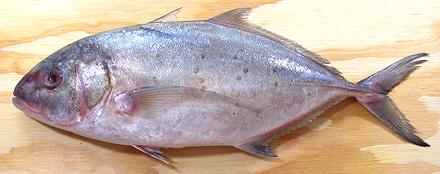 [Carangoides fulvoguttatus]
[Carangoides fulvoguttatus]
Belonging to the same family as Jacks and Pompanos, Yellowspotted Trevally are found in the Indo-West Pacific tropical and subtropical regions.They can grow to 47 inches and nearly 40 pounds, but the photo specimen was 16-3/4 inches and weighed 2 pounds 8-1/2 oz. This fish is Red List rated as NE (Not Evaluated) and is not considered threatened. Like other fish in this family, this is a very fine eating fish.
More on Jacks & Trevally.
This is a delicious fish, and should satisfy anyone who actually likes fish. The lighter flesh has excellent medium flavor and firm texture. The dark streak down the centerline is both wide and deep, but it's flavor is not much stronger. Wimps who don't actually like fish may prefer something more "white and lite", as may many fancy chefs. Because this fish actually has flavor, they would need to think more about their sauces.
Buying: This fish occasionally shows up in Philippine fish markets here in Los Angeles. The photo specimen, sold as "Rainbow Runner", which it certainly was not, was purchased at 2014 US $2.99/pound. If it is not available, the more common Blue Runner can be substituted.
Cooking: This fish cooks well by any reasonable method. As with other Jacks, the flesh stays quite firm, even with wet cooking, but is easily broken into large flakes on the plate.
Scales: Yellowspotted Trevally scales are small and easy to scrape off, forming a slush on smaller fish, but even with larger ones they won't be flying around much. I suggest cutting out the hard scutes at the tail at this point.
Cleaning: The vent is quite far forward, at the tips of the pelvic fins, but the body cavity extends farther back, but not so far you can't easily clean it out. The esophagus is very tough, so cut it with shears. Gills pull out medium hard. You may want to cut them loose with kitchen shears under the chin. I usually cut off the pelvic fins right away as they flop around annoyingly.
Fillet: This fish fillets easily with a coherent bones structure to follow. When you get to the rib cage, cut the ribs from the backbone with kitchen shears and pull them from the fillet with long nose pliers. They pull very easily. There is a row of substantial centerline spines extending for 2/3 of the length of the fish, but they are easy to find and pull out easily straight forward.
Skin: The skin has little shrink but does have a noticeably stronger, oilier taste than the flesh. Coated with a dusting of rice flour, skin-on fillets can be fried, just fry skin up until lightly browned, then turn. In poaching, the skin will curl fillets quite a bit, so should be removed. Fillets can be skinned using the long knife and cutting board Method, but the skin is very thin and delicate, so takes extra care. Fortunately, if you end up with patches of skin still on the fillet, they are much easier to lift off than with most fish. Warning: the row of hard scutes along the lateral line at the tail needs to be cut away before cooking - just the straight part, they are no bother from the start of the curve forward. If not removed, they will come loose in cooking and make your eating experience much less enjoyable.
Yield: A 2 pound 8-1/2 ounce fish yielded 1 pound 6-1/4 ounces of skin-on fillets (55%) and 1 pound 4-3/8 ounces skin-off (50%), a rather good yield.
Stock: Head bones and fins make a very good nearly clear medium flavored stock with very little oil, but I wouldn't use the skins. Remove the oil using your gravy separator. For details see our Fish Stock page.
sf_trevysz 140518 - www.clovegarden.com